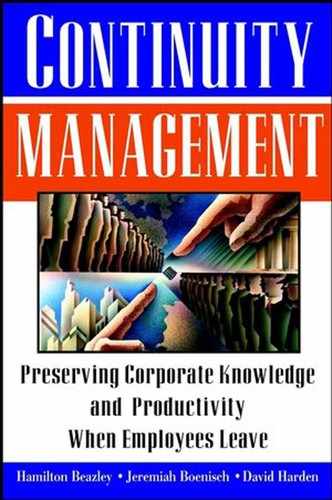Brett's journal in Part II, "Confessions of a Continuity Manager," is a literary device through which to study the principles and concepts of continuity management as they might have been developed in an American company. Its chapters describe the continuity management processes through which critical operational knowledge could be harvested from incumbent employees in an efficient, effective, and comprehensive way, yielding benefits for incumbents, their successors, and their organizations.
Part III departs from the format of Brett's journal and returns to the voice of the authors. While it continues with the practical implementation of continuity management, its subject matter is knowledge transfer and acquisition rather than knowledge harvesting. In other words, it explores the processes through which operational knowledge harvested from incumbent employees can be effectively transmitted, internalized, and acted on by their successors. Knowledge transfer and acquisition is the final set of processes in continuity management. The process of identifying critical operational knowledge and harvesting it from incumbents is incomplete and, ultimately, unproductive unless that knowledge can be successfully transferred to, and applied by, successor employees. We use the term knowledge acquisition in conjunction with transfer in Part III to emphasize that the transfer of knowledge from one employee to another does not constitute continuity management unless the receiving employee also internalizes and applies that knowledge.
Continuity management is designed to ensure both the acquisition of existing operational knowledge transferred by the predecessor and the creation of new knowledge by the successor. In continuity management, knowledge transfer and acquisition form an integrated whole. Increased productivity rests on this duality of knowledge acquisition and creation. For literary purposes, knowledge transfer and acquisition is sometimes abbreviated to knowledge transfer, but acquisition is always implied.
Part III consists of three chapters. Chapter 12 describes the principles and procedures of knowledge transfer and acquisition as they are applied in continuity management. Chapter 13 examines the context in which that transfer and acquisition take place: the organizational culture and reward system. Chapter 14 describes the integration of continuity management and knowledge management.
In Part I, we use the phrase knowledge asset management to refer to an overarching process that integrates the two processes of continuity management (the vertical transfer of knowledge between employee generations) and knowledge management (the horizontal transfer of knowledge within an employee generation). In Chapter 14, we return to this concept of knowledge asset management by describing how knowledge continuity and knowledge management processes can be merged into a holistic process of knowledge asset management that expands an organization's knowledge base and maximizes the exploitation of its knowledge asset.
